You’ve probably heard that boiling water kills weeds. It’s one of those tips that floats around—usually mentioned right after vinegar and just before something involving Dawn dish soap.
But does it actually work?
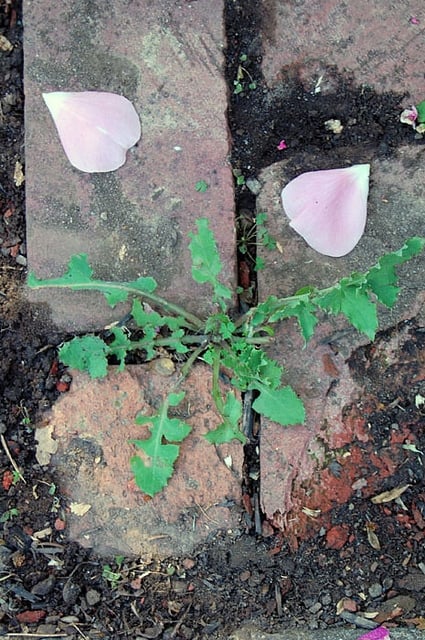
Sort of. On some weeds. In certain places. If you do it right. It won’t touch anything with a deep taproot unless you’re committed to repeat treatments. But for weeds growing in sidewalk cracks or between bricks, it works. Not instantly. Not perfectly. But it works!
This is what happens when you use it—and what to expect if you do.
Table of Contents
Does boiling water kill weeds—yes or no?
Yup. It does. Sort of.
If you pour boiling water on a weed, the leaves collapse like they’ve been caught rolling their eyes in church. They go limp. They shrink to half their size. They eventually go brown and die.
But then? Sometimes they grow back.
Why? Because weeds are petty little things with deep, vengeful roots. Especially the ones with taproots—like dandelions, dock, and plantain. You might have to hit them many times before they finally give up and move on to the great sidewalk crack in the sky.
Pro tip to remember: Use a kettle, not a pot. Kettles are precise. Pots are boiling water wave parks.
How boiling water actually affects weeds
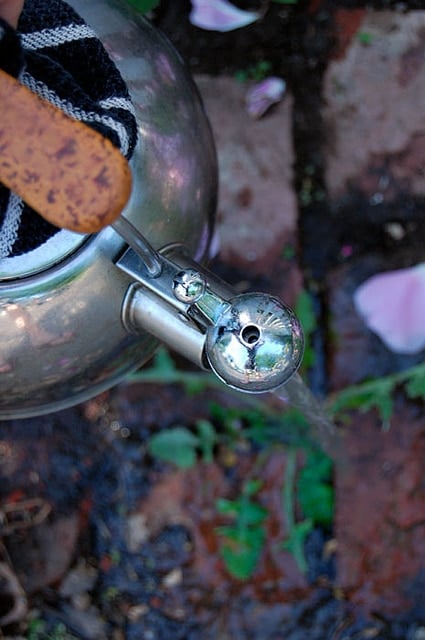
Instant effects on foliage
The moment that scalding water hits the leaves, it's like flipping a switch. The plant cells rupture from the heat.
It’s deeply satisfying. Visually. Emotionally. Spiritually, even.
Impact on roots
Under the surface? Not as dramatic.
Boiling water can damage the crown or top of the taproot if you saturate it enough. But unless you pour a lot, or do it more than once, the deeper root stays alive. It’s just down there. Plotting its comeback.
Weeds with shallow roots though? This works great on them.
Why some weeds bounce back
Taprooted weeds store energy. The moment the top gets damaged, the root kicks into emergency mode. New leaves. New shoots. Like nothing ever happened.
But even taproots only have so much energy. Eventually, if they can’t recharge with new leaves, they die.
The Trick
If you want to kill something like a dandelion with boiling water, here’s how:
Repeat the boiling water treatment 5 or 6 times. Every time you see even a tiny bit of green, pour more boiling water on it. It’s annoying. But it works. Eventually, the root runs out of energy and dies.
When boiling water works best
1 hour later
2 days later
Good Uses :
- Sidewalk cracks
- Between patio stones
- Gravel driveways
- Dry, compacted areas where nothing else grows anyway
These weeds usually don’t have deep roots. One or two treatments and you’re good.
Would you like to save this stuff?
Terrible Uses:
- Grass – You’ll have dead spots everywhere.
- Garden beds – Risky. Boiling water doesn't discriminate. It’ll kill your kale as fast as your chickweed. Not that anyone’s mourning the kale.
- Dandelions in your lawn – Unless you’re into polka-dotted grass, maybe don’t.
How to use boiling water safely
What you need
- Electric or stovetop kettle
- Long sleeves (trust me)
- Closed shoes (not flip flops, not barefoot, not once, not never)
- A killer instinct
Don’t use a giant pot unless you want to slosh boiling water down your legs. I don’t recommend that. Kettle. Always a kettle.
How much to use & how often
Pour slowly and directly over the weed’s crown. Soak it. Let it sizzle a bit. Walk away. It'll be brown soon.
Come back in a week. If it’s looking perky again, repeat.
Usually takes 2–5 rounds, spaced about a week apart, depending on the type of weed and root. You’re basically wearing the weed down until it taps out.
Avoid splash damage
Be careful near garden beds or anything you don’t want dead. The heat spreads underground a little and can fry the roots of nearby plants.
Aim carefully and pour slowly.
The Results
- 1 hour later – Wilted, floppy, green leaves
- 2 days later – Crispy brown death
- Larger weeds – May need more treatments
- Deep roots – Still alive, but not happy
Pros and cons
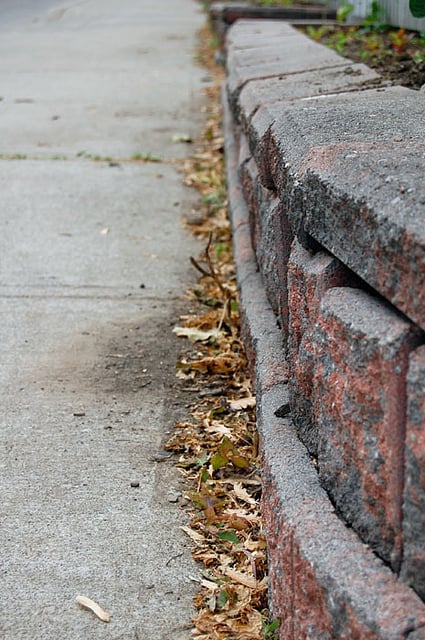
The good:
- No chemicals. No danger. No birds growing beaks out of their bellybuttons.
- You’ll see wilting in minutes. Yay!
- You have everything at home to do it right now.
The annoying:
- Doesn’t always kill the root
- Needs repeating
- Kills everything it touches
- A lot of kettle refills if you’re dealing with a big area
What nobody tells you
Seal the cracks
Once the weeds are genuinely dead, sweep up the corpses and fill the gaps with sand or polymeric filler. Otherwise, the cracks are just open invitations for the next round.
Lots of weeds = lots of water
If you're treating a long driveway or entire patio, boiling water gets old fast. Waiting for kettles to boil over and over again is—how do I put this—painfully boring.
Got a big job?
Rent a proper weed steamer. Yes, there is too such a thing. It’ll cover a bigger area much faster.
Anyway. That’s how I spent an afternoon boiling weeds to death.

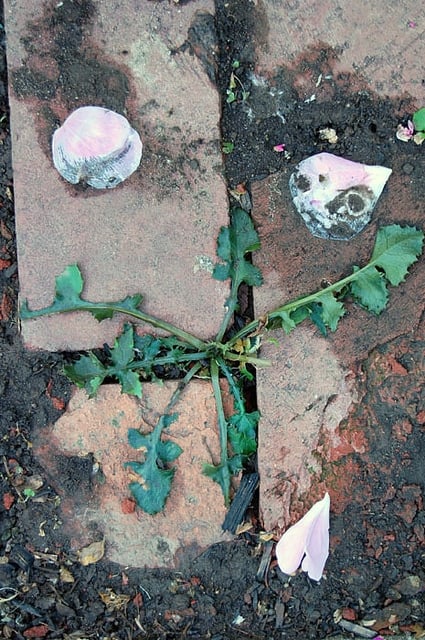
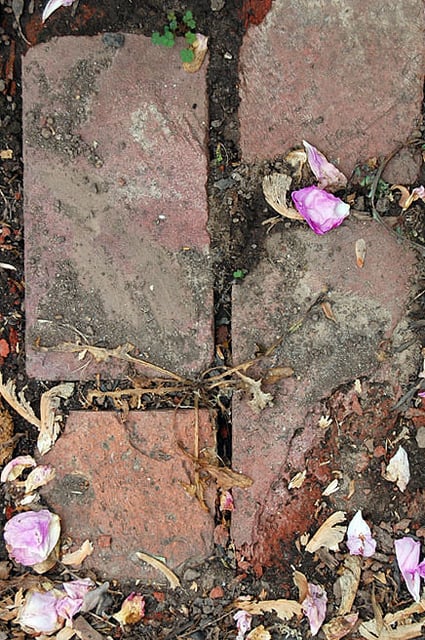


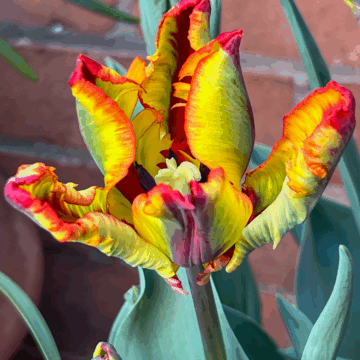
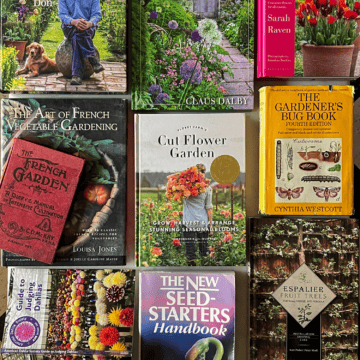
Sandra Blackwell
My husband has a propane flamer. He swears by it killing the weeds. It does not. But it does catch the mulch in the other side of the landscape blocks on fire...while he is happily down the sidewalk flaming away...fortunately I saw it before the whole yard went up and raced in to get the sprinkler on it. And two weeks later I went out with the weed whacker to cut if the weeds he torched.
QuatorzeM
We live in Florida and have quite a bit of sediment left in our kettle. So, I often fill the kettle with vinegar. When the vinegar has boiled long enough to dissolve the sediment, I take the kettle outside and pour the hot vinegar in the driveway cracks. It works great!
Cara
Good simple solution with lots of helpful warnings.
I thought adding vinegar to water (and not even HOT water) would kill weeds between cracks.
Karen
It can, using vinegar is a different technique but basically the same thing. ~ karen!
Kim
I've always wanted to have the time for a propane flame thrower. Wonder if it works and if yes, would it also work for evil ant beds?? things that keep ya up at night :(
Kat - the other 1
Why would you want to kill plantain?
Isn't that a medicinal herb and salad green?
Karen
Because I have a doctor, a pharmacy and romaine lettuce. ;) ~ karen!
Sylvia
Hot water and vinegar always worked for me in crevices and cracks in driveway and gaps in paths.
LEEANNE BLOYE
A few years back, I boiled the kettle to get rid of a dandelion growing between paving bricks where the bbq is.
When I poured the water, a poor scalded earth worm came writhing out of the ground. Never again. Luckily my paving area is small and I'm out there often waiting for things to cook, so I just yank and eventually the dandelions give up.
Audrey
I'm with you Leeanne - vinegar I can see, but worms are the good guys and boiling water gives them no chance to get away, plus prolonged suffering. There's enough of that in nature already (think birds and worms), without us adding to it. Most of the time Karen nails it, and I rarely miss a post from her, but on this one I had to comment.
Karen
Hi Audrey! Good news. Worms don't live in sidewalk cracks, bricks, cement or any of the other places I recommend you do this. Even if you were to pour boiling water onto a dandelion growing in the middle of a soil garden bed the chances of it hitting a worm before the water cools down to just "warm" are very, very slim. ~ karen!
Ann
Boiling water works well if done while the weeds are still very young. It does help to add just a little salt, especially if using it on the areas you mention above, on sidewalk cracks, gravel pathways, ect.
I also have pretty good luck with 45-50% concentrated vinegar. Again it sometimes needs to be used more than once if the weed is already established. But spray on young weeds, any young weed, and they are gone in a matter of an hour if you spray on a very sunny warm day.